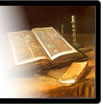"I
tell you," Jesus replied, "if they
[my disciples] keep quiet, the very stones will cry out."
Archaeology
is the study of non-perishable debris, the
rubbish man has left behind him that has survived the ravages of
time. The task of the archaeologist is to take what remains from
a society and reconstruct what the artifacts tell us.
Early
digs were driven by the hope of finding buried treasure. Today, scientific
methods are used to recover and study the remains of the past in
order to better understand the ancient people and their lives.
Archaeology
without history gives us only a sequence of cultural development.
History gives us the chronology, events, people, places. Archaeological
finds of the past one hundred years have verified much of the Bible's
history. So far, the findings have verified, and in no case disputed,
the historical biblical record.
While
archaeology can not prove the Bible is the Word of God, it can illustrate
the accuracy of many biblical passages and shed light on various
passages in the Bible. You are on solid ground arguing that archaeology
confirms the historical accuracy and trustworthiness of the Bible,
that it can illuminate formerly obscure passages. You are on shaky
ground to claim it proves divine inspiration or revelation.
"One cannot stress too
strongly the importance of the Bible giving an accurate historical picture. Christianity is a historical faith which claims that God has broken
into history with many mighty acts. ... If the biblical writers were
incorrect in their historical picture, serious doubt would then be cast
upon their trustworthiness in areas which couldn't be verified. ...
[But] if the authors of Scripture are accurate in their accounts
of the things that transpired, it then follows that they cannot be
ruled out of court because they happen to mention things out of the
ordinary."
Josh McDowell and Don Stewart, Answers
Archaeological Support
for the Bible
From
Genesis to Revelation, there is not a book in the Bible that can
not draw support from the field of archaeology. There are libraries
of books devoted to the subject, and archaeologists are constantly
digging up new revelations. Some of the highlights follow. Information
has been drawn from several sources, including: Josh McDowell, New
Evidence that Demands a Verdict; Josh McDowell and Don Stewart, Answers; Bryant Wood, archaeologist,
Association for Biblical Research, as read on the web at christiananswers.net;
The Oxford Bible Atlas; and Roberta Harris, Exploring the World of
the Bible Lands. Other sources are cited as they are listed.
Biblical
scholars once believed Moses could not have written the Pentateuch
because it had been proven that writing was not in existence at the
time of Moses. Therefore, it had to be of later authorship. Then,
the "black stele" was discovered, containing the detailed
laws of Hammurabi. It preceded Moses' writings
by at least three centuries.
The Ebla Archives
One
of the greatest archaeological finds in this century, Ebla was discovered in northern Syria in the 1970s. Excavations at Tell Mardikh, now known to be the site of Ebla, uncovered a palace which yielded some 15,000
clay tablets dating circa 2300 BC. Though most have not yet been
translated, those that have demonstrate that the ancient site was
once the prestigious city of Ebla, which ruled the Near East as the seat of a great empire. It is located
in the modern-day city of Aleppo in North Syria. Its existence coincides with the time of
the biblical patriarchs. The tablets provide an abundance of background
material and biblical place names.
Among
other things, the tablets mention Sodom and Gomorrah, previously thought by some to be mythical
cities. The Ebla archives also preserve place names such as Hazor, Megiddo, Jerusalem, Lachish, Dor, Gaza, Ashtarot, and
others. Personal names and common names of the time are also recorded,
and correspond with the names we read from that time in biblical
history.
Many
words deemed "late words (600 BC) or Aramaisms (words
influenced by Aramaic) can now be determined to be ancient. If they
were used in Ebla in 2300, then they can hardly be lately developed.
Critics
have long said Canaan was a word not used at the time of Moses
and was used incorrectly in the early chapters of the Bible. Another
word, "tehom" ("the deep")
was said to be a late word (around 600 BC) and to prove a late writing
of the creation account. Both the land of Canaan and the word "tehom" were
found on the Ebla tablets, which predated Moses by some 800
years. Kitchen wrote of the Ebla archives:
"The lessons here are
- or should be - clear. Set against two thousand years of history
and development of the West Semitic dialects, the whole position
of the dating of the vocabulary and usages in biblical hebrew will
need to be completely re-examined."
K.A. Kitchen, The Bible
in Its World
The Ebla archives also verify pagan religious practices
of the time, also recorded in the Bible: the existence of temples,
belief in certain gods, offerings, etc.
Old Testament Rulers and
Empires
Many
scholars of the eighteenth and nineteenth centuries thought there
were no Hittites at the time of Abraham because there were no records
of them outside the Old Testament. The Hittites were thought to be
biblical legend. Wrong again. Archaeological research has since uncovered
evidence revealing more than 1,200 years of Hittite civilization.
The capital and records were discovered at Bogazkoy, Turkey in 1906.
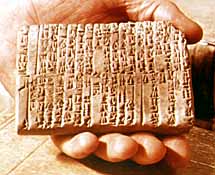 The
Sumerian King List is an ancient tablet listing kings who reigned
for long periods of time. The tablet records a great flood, after
which there was a break in which no kings reigned, and when they
were reinstated their reigns were much shorter. This corresponds
with the Bible's record that the human life span was shortened following
the flood. The
Sumerian King List is an ancient tablet listing kings who reigned
for long periods of time. The tablet records a great flood, after
which there was a break in which no kings reigned, and when they
were reinstated their reigns were much shorter. This corresponds
with the Bible's record that the human life span was shortened following
the flood.
Scholars
once claimed that no Assyrian King Sargon ever lived, because the
Bible was the only record of such a person (Isaiah 20:1). Then his
palace was discovered in Khorsabad, Iraq. The very event recorded in Isaiah 20-his
capture of Ashdod-was recorded on the palace walls.
According
to recorded history, the last king of Babylon was Nabonidus.
The Bible, however, records a King Belshazzar,
who reigned during the time of the prophet Daniel. Critics thought this was a biblical error,
until tablets were found showing Belshazzar as Nabonidus' son, who served as co-regent with his father.
Thus Belshazzar could offer to make Daniel "third highest ruler in the kingdom" (Daniel 5:16) for reading the handwriting on the wall-the
highest available position. (Bryant Wood, archaeologist, Association
for Biblical Research; christiananswers.net)
Sodom and Gomorrah
The
destruction of Sodom and Gomorrah was thought to be mythical until evidence
revealed the existence of these cities as centers of commerce in
the area where the Scriptures describe them. The biblical description
of their demise seems to be no less accurate. Evidence points to
earthquake activity, and bituminous pitch, which would be explained
by the brimstone hurled down on those cities that had rejected God.
There is even evidence that the layers of sedimentary rock were molded
together by intense heat, and evidence of burning has been found
on Mount Sodom. Secular archaeologists have suggested that
an oil basin beneath the Dead
Sea ignited and erupted.
Whether or not this is true, "Such an explanation in no way
subtracts from the miraculous quality of the event, for God controls
natural forces. The timing of the event, in the context of warnings
and visitation by angels, reveals its overall miraculous nature." (Norman Geisler,
Baker Encyclopedia of Christian Apologetics)
Jericho
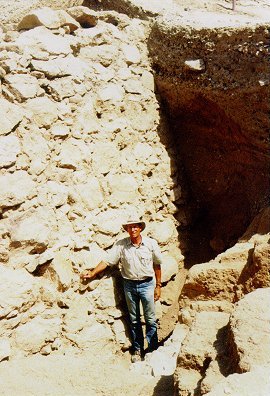 Excavations
of Jericho between 1930 and 1936 revealed something
so startling that John Garstang and two
other members of the archaeological team prepared and signed a statement
describing what was found. In reference to these findings, Garstang says: Excavations
of Jericho between 1930 and 1936 revealed something
so startling that John Garstang and two
other members of the archaeological team prepared and signed a statement
describing what was found. In reference to these findings, Garstang says:
"As to the main fact,
then, there remains no doubt: the walls fell outwards so completely
that the attackers would be able to clamber up and over their ruins
into the city. Why so unusual? Because the walls of cities do not
fall outwards, they fall inwards. And yet in Joshua 6:20 we read, 'The wall fell down flat. Then the
people went up into the city, every man straight before him, and
they took the city.' The walls were made to fall outward."
John Gartsang, The Foundation
of Bible History, Joshua, Judges
Bryant
Wood, writing for Biblical Archaeology Review, includes a list of
collaboration between archaeological evidence and biblical narrative
as follows:
1. The city was strongly fortified (Joshua 2:5,
7, 15; 6:5, 20).
2. The attack occurred just after harvest time
in the spring (Joshua 2:1; 3:15; 5:16).
3. The inhabitants had no opportunity to flee
with their foodsheds (Joshua 6:1).
4. The siege was short (Joshua 6:15).
5. The walls were leveled, possibly by an earthquake
(Joshua 6:20).
6. The city was not plundered (Joshua 6:17, 18).
7. The city was burned (Joshua 6:24).
Saul, David, and Samuel
Saul's
fortress at Gibeah has been excavated.
One noteworthy find was that slingshots were one of the primary weapons
of the day. This relates not only to David's victory over Goliath,
but to the reference of Judges 20:16 that there were 700 expert slingers who "could
sling a stone at a hair and not miss."
Upon
Saul's death, Samuel tells us that his armor was put in the temple of Ashtaroth (a Canaanite fertility goddess) at Bet She'an, while Chronicles records that his head was put in
the temple of Dagon, the Philistine corn god. This was thought
to be an error because it seemed unlikely that enemy peoples would
have temples in the same place at the same time. However, excavations
have revealed that there are two temples at this site that are separated
by a hallway: one for Dagon and the other for Ashtaroth.
One
of the key accomplishments of David's reign was the capture of Jerusalem. Problematic in Scripture was that the Israelites
entered the city by way of a tunnel that led to the Pool of Siloam.
However, that pool was thought to be outside the city walls. Excavations
in the 1960s revealed that the wall did indeed extend well past the
pool.
The
site of Solomon's temple can not be excavated due to its nearness
to the Muslim holy site The Dome of the Rock. However, Philistine
temples built in Solomon's time fit the design, decoration, and materials
described in the Bible. One ornament with the inscription "belonging
to the Temple of Yahweh" has been recovered and is in the Israel Museum.
The
excavation of Gezer in 1969 ran across a massive layer of ash
that covered most of the mound. Sifting through
the ash yielded pieces of Hebrew, Egyptian, and Philistine artifacts. Apparently,
all three cultures had been there at the same time. This puzzled
researchers greatly until they realized that the Bible confirms exactly
what they found. "Pharaoh king of Egypt had attacked and captured Gezer. He had set it on fire. He killed its Canaanite
inhabitants and then gave it as a wedding gift to his daughter, Solomon's
wife." (1 Kings 9:16)
A
remarkable inscription from the ninth century BC that refers to both
the House of David and to the King of Israel was discovered in 1994.
This was the first time the name of David had been found in any ancient
inscription outside the Bible. The inscription refers not simply
to a David, but to the House of David, the dynasty of the great Israelite
king. It is possibly the oldest extra-biblical reference to Israel in Semitic script. It proves that both Israel and Judah were important kingdoms at this time.
Other Examples of Extra-biblical
Confirmation of Biblical Events
(from Bryant
Wood)
¥ Campaign into Israel by Pharaoh Shishak (1
Kings 14:25-26), recorded on the walls of the Temple of Amun in Thebes, Egypt.
¥ Revolt
of Moab against Israel (2 Kings 1:1; 3:4-27) to
Sargon II, king of Syria, as recorded on his palace
walls.
¥ Defeat of Ashdod by Sargon II (Isaiah 20:1), as recorded on
his palace walls.
¥ Campaign of the Assyrian
king Sennacherib against Judah (2 Kings 18:13-16), as recorded on the Taylor Prism.
¥ Siege of Lachish by Sennacherib (2 Kings 18:14, 17), as recorded on the Lachish reliefs.
¥ Assassination of Sennacherib
by his own sons (2 Kings 19:37) as recorded in the annals of his son Esarhaddon.
¥ Fall of Jerusalem to Nebuchadnezzar, king of Babylon (2 Kings 24: 10-14) as recorded in the Babylonian
Chronicles.
¥ Captivity of Jehoiachin,
king of Judah, in Babylon (2 Kings 24:15-16) as recorded on the Cyrus
Cylinder.
¥ Freeing of captives in Babylon by Cyrus the Great (Ezra 1:1-4; 6:3-4), as
recorded on the Cyrus Cylinder.
¥ The existence of Jesus
as recorded by Josephus, Suetonius, Thallus,
Pliny the Younger, the Talmud, and Lucian.
¥ Forcing Jews to leave Rome during the reign of Claudius (AD 41-54) (Acts
18:2), as recorded by Suetonius.
Tombs and Burial Sites
Burial
sites of many people from the Bible have been found. Just as a tombstone
today is used as "concrete" evidence of a person's life
and death, so the tombs and sepulchers of the past can be used to
determine the life and significance of those they contain.
The
tomb of Jesus in Jerusalem has been identified since the first century
as that which is now beneath the Church of the Holy Sepulcher. In
the 1800s, the Garden Tomb was identified as the temporary resting
place for the body of Christ. The Church of the Holy Sepulcher is
generally accepted as the correct location.
 Caiaphas was high priest from AD 18-36. He was the leader
of the conspiracy to crucify Jesus. After his arrest, Jesus was detained
at Caiaphas' house overnight. Caiaphas interrogated
Jesus and handed him over to Pilate to be tried. Caiaphas continued to persecute the early church and the
disciples (Acts 5:28-29). The Caiaphas family
tomb was accidentally discovered by workers constructing a road in
a part just south of the Old City of Jerusalem. Archaeologists examined
the tomb and found twelve ossuaries (receptacles for bones) containing
the remains of 63 individuals, including those of Caiaphas.
This remarkable discovery was the first to provide the physical remains
of an individual named in the Bible. Caiaphas was high priest from AD 18-36. He was the leader
of the conspiracy to crucify Jesus. After his arrest, Jesus was detained
at Caiaphas' house overnight. Caiaphas interrogated
Jesus and handed him over to Pilate to be tried. Caiaphas continued to persecute the early church and the
disciples (Acts 5:28-29). The Caiaphas family
tomb was accidentally discovered by workers constructing a road in
a part just south of the Old City of Jerusalem. Archaeologists examined
the tomb and found twelve ossuaries (receptacles for bones) containing
the remains of 63 individuals, including those of Caiaphas.
This remarkable discovery was the first to provide the physical remains
of an individual named in the Bible.
Caesar
Augustus ruled the Roman empire from 27 BC to AD 14. He issued the census decree that brought
Mary and Joseph to Bethlehem. The remains of Augustus' tomb exist today
in the middle of the Piazza Augusto Imperatore.
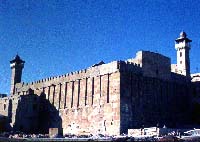 The
Bible says that Sarah, Abraham, Isaac, Rebekah,
Leah, and Jacob were buried in Hebron, in a cave called the Cave of Machpelah, purchased by Abraham (Genesis 23). Traditionally,
this cave has been located below the Haram el-Khalil ("sacred
precinct of the friend of the merciful one, God") in Hebron, today a Muslim mosque. References as early as the second century
BC testify that this is the authentic location of the burial place
of the patriarchs. The cave was explored by the Augustine Canons
in 1119, at which time they claim to have found the bones of the
patriarchs. The
Bible says that Sarah, Abraham, Isaac, Rebekah,
Leah, and Jacob were buried in Hebron, in a cave called the Cave of Machpelah, purchased by Abraham (Genesis 23). Traditionally,
this cave has been located below the Haram el-Khalil ("sacred
precinct of the friend of the merciful one, God") in Hebron, today a Muslim mosque. References as early as the second century
BC testify that this is the authentic location of the burial place
of the patriarchs. The cave was explored by the Augustine Canons
in 1119, at which time they claim to have found the bones of the
patriarchs.
Kings
of Judah were buried within the city of David. At the southern end of the city, south of
the Old City of Jerusalem, there are two monumental tunnel tombs
which many scholars believe are the tombs of David and Solomon. They
have been damaged by quarrying, so no identifying inscriptions have
survived. One king of Judah, Uzziah, was an exception to the burial custom. As a leper,
he was not buried near the other kings, but "near them in a
field" (2 Chronicles 26:23). In 1931, an inscription was found
on the Mount of Olives dating to the first century AD: "Here
were brought the bones of Uzziah, King
of Judah - do not open." His bones had apparently
been moved from the field and transferred to a yet more remote location.
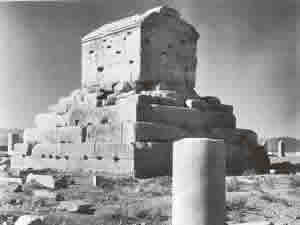 Cyrus
the Great ruled the Persian empire from 559 to 530 BC and is best know for his capture of Babylon in 539 BC, predicted by Isaiah some 160 years
earlier. Cyrus was buried in a simple gabled stone tomb outside his
capital of Pasargadae in modern Iran. According to the historian Strabo, this inscription once graced the structure, "Oh
man, I am Cyrus, the son of Cambyses, who
founded the empire of Persia, and was king of Asia. Grudge me not therefore this monument." Cyrus
the Great ruled the Persian empire from 559 to 530 BC and is best know for his capture of Babylon in 539 BC, predicted by Isaiah some 160 years
earlier. Cyrus was buried in a simple gabled stone tomb outside his
capital of Pasargadae in modern Iran. According to the historian Strabo, this inscription once graced the structure, "Oh
man, I am Cyrus, the son of Cambyses, who
founded the empire of Persia, and was king of Asia. Grudge me not therefore this monument."
Darius
I the Great was king of the Persian empire from 522 to 486 BC. He gave permission to renew the rebuilding
of the temple (Ezra 6:1-12). His monumental tomb is cut into a cliff
near the Persian capital of Persepolis, Iran. There are three other tombs there, thought
to be those of the Persian king Xerxes (485-465 BC; married to Esther); Artaxerxes (465-424 BC; king while Ezra was a scribe and
Nehemiah was a cupbearer; authorized Nehemiah to rebuild the city
walls); and Darius II (423 to 405 BC; perhaps the Darius mentioned
in Nehemiah 12:22?). However, aside from the tomb of Darius
I, there are no accompanying inscriptions, so these identifications
are uncertain.
Statues and Other Likenesses
Carvings
and statues provide further evidence of the existence of biblical
characters. Such likeness have been discovered
for twelve Old Testament figures and six from the New Testament.
These include (also taken from Bryant Wood):
¥ Pharaoh Tuthmosis III,
1504-1450 BC (Pharaoh of Egypt, possibly during the Exodus)
¥ Shishak,
the Egyptian king who plundered the Temple during the reign of Rehoboam (1
Kings 14:25-26)
¥ Jehu,
king of Israel, who took power in a bloody coup; the only
surviving likeness of a king of Israel or Judah (2 Kings 9:1-10, 36)
¥ Hazael,
king of Aram, enemy of Israel (1Kings 19:15,
17; 2 Kings 8:7-15, 28-29; 9:14-15; 10:32-33; 12:17-18; 13:3, 22,
24, 25; Amos 1:4)
¥ Tiglath-Pileser III,
king of Assyria, who invaded Israel (2 Kings 18:19, 29; 16:7, 10; 1 Chronicles 5"6, 26;
2 Chronicles 28: 20)
¥ Sargon II, king of Assyria, who defeated Ashdod and completed the siege of Amaria and took Israelites into captivity (Isaiah 20:1)
¥ Sennacherib, king of Assyria, who attacked Judah but was unable to capture Jerusalem (2 Kings 18:13
- 19:37)
¥ Tirhakah,
king of Egypt, who opposed Sennacherib (2 Kings 19:9)
¥ Esarhaddon,
king of Assyria, who succeeded his father Sennacherib (2
Kings 19:37)
¥ Merodach-baladan,
king of Babylon, whose messengers Hezekiah showed the royal
treasury, much to the indignation of Isaiah (2 Kings 20:12-19)
¥ Xerxes I, king of Persia, who made Esther his queen (Esther; Ezra
4:6)
¥ Darius I, king of Persia, who allowed the returning exiles to rebuild
the Temple in Jerusalem (Ezra 4:24 - 6:15; Haggai 1:1, 15)
¥ Augustus, Roman emperor,
27 BC to AD 14, when Jesus was born (Luke 2:1)
¥ Tiberius, Roman emperor,
AD 14 to 37, during Jesus' adulthood and crucifixion (Matthew 22:17
¥ Claudius, Roman emperor,
AD 41 to 54, who ordered the Jews to leave Rome (Acts 11:28; 17:7; 18:2)
¥ Herod Agrippa I, ruler
of Judea AD 37 to 44, who persecuted the early church
(Acts 12:1-23; 23:35)
¥ Aretas IV,
king of the Nabateans, 9 BC to AD 40, whose
governor in Damascus attempted to arrest Paul (2 Corinthians 11:32)
¥ Nero (referred to as Caesar
in the New Testament), Roman emperor, AD 54 to 68, whom Paul appealed
to (Acts 25:11, 12, 21; 26:32; 28:19; Philippians 4:22)
Many
man-made structures also have been excavated, some of which follow (courtesy
Bryant Wood; also Josh McDowell, New Evidence that Demands a Verdict):
¥ The palace at Jericho where Eglon, king
of Moab, was assassinated by Ehud (Judges 3:15-30)
¥ The east gate of Shechem where Gaal and Zebul watched the forces of Abimelech approach
the city (Judges 9:34-38)
¥ The temple of Baal/El-Berith in Schechem, where
funds were obtained to finance Abimelech's kingship
and where the citizens of Shechem took
refuge when Abimelech attacked the city
(Judges 9:4, 46-49)
¥ The Pool of Heshbon,
likened to the eyes of the Shulammite woman
(Song of Songs 7:4)
¥ The royal palace at Samaria where the kings of Israel lived (1 Kings 20:43; 21:1, 2; 22:39; 2 Kings 1:2; 15:25)
¥ The Pool of Samaria where
King Ahab's chariot was washed after his death (1 Kings 22:29-38)
¥ The water tunnel beneath Jerusalem dug by King Hezekiah to provide water during
the Assyrian siege (2 Kings 20:20; 2 Chronicles 32:30)
¥ The royal palace in Babylon where King Belshazzar held
the feast and Daniel interpreted the handwriting on the wall (Daniel 5)
¥ The royal palace in Susa where Esther was queen of the Persian king
Xerxes (Esther 1:2; 2:3, 5, 9, 16)
¥ The royal gate at Susa where Mordecai met with Halthach,
Xerxes' eunuch (Esther 4:6)
¥ The foundation of the synagogue
at Capernaum where Jesus cured a man with an unclean spirit
(Mark 1:21-28) and
delivered the sermon on the bread of life (John 6:25-59)
¥ The house of Peter at Capernaum where Jesus healed Peter's mother-in-law
and others (Matthew 8:14-16)
¥ Jacob's well, where Jesus
spoke to the Samaritan woman (John 4)
¥ The Pool
of Bethesda in Jerusalem, where Jesus healed a crippled
man (John 5:1-14). This
site was recorded nowhere except in the New Testament, but can
now be identified in the northeast quarter of the old city. Traces
of it were discovered in the course of excavations near the Church of St. Anne in 1888.
¥ The Pool of Siloam in Jerusalem, where Jesus healed a blind man (John 9:1-4)
¥ The tribunal at Corinth where Paul was tried (Acts 18:12-17)
¥ The theater at Ephesus where the riot of silversmiths occurred (Acts 19:29)
¥ Herod's palace at Caesarea where Paul was kept under guard (Acts 23:33-35)
¥ The pavement. For centuries there has been no record of
the court where Jesus was tried by Pilate (named Gabbatha,
or the Pavement, John 19:13). William F. Albright, in The Archaeology
of Palestine, shows that this court was the court of the Tower of Antonia, the Roman military headquarters in Jerusalem. It was left buried when the city was rebuilt
in the time of Hadrian, and was not discovered until recently.
¥ The Pilate
Inscription. A
Latin inscription discovered in 1961 contained four lines, three
of which were readable: "Tiberium,
Pontius Pilate, Prefect of Judea." This inscription clarifies the title
of Pontius Pilate as "prefect" at least during a time
in his rulership. Tacitus and Josephus
later referred to him as "procurator." The New Testament
calls him "governor" (Matthew 27:2), a term which incorporates
both titles. This inscription is the only archaeological evidence
of both Pilate's name and this title.
¥ Three coins mentioned in
the New Testament have been identified: the "tribute penny" or "denarius," equivalent to a day's wages; the 2/5 ounce
silver coin that developed from the shekel (used in Judas' thirty
pieces of silver, Matthew 26:14-15); and the "widow's mite" (Mark
12:41-44; Luke 21:1-4), small copper coins worth only a fraction
of a penny.
Luke as a Historian
Luke,
the writer of the Gospel of Luke and the Book of Acts, has been attacked
by scholars as an inaccurate historian. However, discoveries over
the last century have vindicated Luke, proving him right to the smallest
detail. Many of the fallacies formerly believed of Luke's writings
follow:
At
one time, it was conceded as fact that Luke was entirely wrong about
the events surrounding the birth of Jesus. Critics argued that there
was no census, and that everyone did not have to return to his ancestral
home. They also argued that Quirinius was
not governor of Syria at that time, but became governor around
AD 6.
Archaeological
discoveries show that the Romans did have a regular enrollment of
taxpayers and held censuses every fourteen years, a procedure begun
during the reign of Augustus.
Archaeologists
also discovered an inscription fount in Antioch ascribing to Quirinius the
governorship of Syria around 7 BC. Thus he was governor twice,
in AD 6, as recorded by Josephus, and during the time of the early
Roman census during which Christ was born. Luke does not ignore the
later census conducted by Quirinius, but
mentions it is Acts 5:37
An
Egyptian papyrus was also discovered which gives directions for the
conduct of a census. It reads: "Because of the approaching census
it is necessary that all those residing for any cause away from their
homes should at once prepare to return to their own governments in
order that they may complete the family registration of the enrollment
and that the tilled lands may retain those belonging to them."
Archaeologists
at first believed Luke's implication wrong that Lystra and Derbe were
in Lycaonia, and that Iconium was
not (Acts 14:6). They based their belief on the writings of Romans
such as Cicero, who indicated that Iconium was in Lycaonia. However,
in 1910 Sir William Ramsay found a monument that showed that Iconium was a Phrygian city. Later discoveries have confirmed
this.
Archaeological
finds have identified most of the cities mentioned in the Book of
Acts. The journeys of Paul can thus be accurately traced.
"In all, Luke names
thirty-two countries, fifty-four cities and nine islands without
an error."
Norman Geisler,
Baker Encyclopedia of Christian Apologetics
Luke
also references Lysanias, Tetrarch of Abilene,
who ruled in Syria and Palestine (Luke 3:1) at the beginning of John the Baptist's
ministry in AD 27. The only Lysanias known
to ancient historians was killed in 36 BC, thus it was assumed that
Luke was in error. However, an inscription found at Abila near Damascus confirms the existence of "Lysanias the Tetrarch" and is dated between AD 14 and
29, perfectly supporting Luke's record.
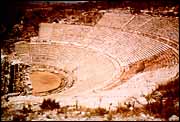 Excavations
revealed the theater at Ephesus at which Luke records a riot (Acts 19:23-29). Luke also records a riot in Jerusalem because Paul took a Gentile into the temple
(Acts 21:28). Greek and Latin inscriptions have been
found that read: "No foreigner may enter within the barrier
which surrounds the temple and enclosure. Anyone who is caught doing
so will be personally responsible for his ensuing death." Excavations
revealed the theater at Ephesus at which Luke records a riot (Acts 19:23-29). Luke also records a riot in Jerusalem because Paul took a Gentile into the temple
(Acts 21:28). Greek and Latin inscriptions have been
found that read: "No foreigner may enter within the barrier
which surrounds the temple and enclosure. Anyone who is caught doing
so will be personally responsible for his ensuing death."
Luke's
word choice was often called into question, too. His reference to Phillippi as a district of Macedonia was considered an error, as
were his references to Philippian rulers
as praetors, civil authorities of Thessalonica as politarchs,
and use of the title proconsul for Gallio.
All of these "errors" of Luke have since been verified
by inscriptions or other archaeological finds. His use of the term "politarch," once
considered conclusive evidence of Luke's unreliability, has since
been vindicated. More than a dozen inscriptions have been unearthed
in recent years which make use of that ancient Greek title.
"The Acts of the Apostles
is now generally agreed in scholarly circles to be the work of Luke,
to belong to the first century, and to involve the labors of a careful
historian who was substantially accurate in his use of sources."
Merrill F. Unger, Archaeology
and the New Testament
"For Acts the confirmation
of historicity is overwhelming. ... Any attempt to reject
its basic historicity must now appear absurd. Roman historians
have long taken it for granted."
A.N. Sherwin-White, Roman
Historian
Dead Sea Scrolls
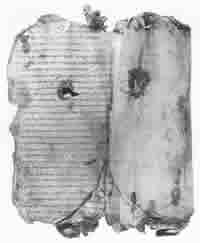 The
most famous biblical archaeological discovery of the past century,
the Dead Sea Scrolls, did much to confirm the accuracy of transcription
of the Bible since its original writings. The scrolls merit mention
as
an archaeological find. The following pages, written by Dr. Will Varner and taken from christiananswers.net. The
most famous biblical archaeological discovery of the past century,
the Dead Sea Scrolls, did much to confirm the accuracy of transcription
of the Bible since its original writings. The scrolls merit mention
as
an archaeological find. The following pages, written by Dr. Will Varner and taken from christiananswers.net.
"Problems still exist,
of course, in the complete harmonization of archaeological material
with the Bible, but none so serious as not to bear real promise of
imminent solution through further investigation. It must be extremely
significant that, in view of the great mass of corroborative evidence
regarding the biblical history of these periods, there exists today
not one unquestionable find of archaeology that proves the Bible
to be in error at any point."
Morris, The Bible
and Modern Science, 95
"In every period of
Old Testament history, we find that there is good evidence from archaeology
that the Scriptures speak the truth. In many instances, the Scriptures
even reflect firsthand knowledge of the times and customs it describes.
While many have doubted the accuracy of the Bible, time and continued
research have consistently demonstrated that the Word of God is better
informed than its critics.
"In fact, while thousands
of finds from the ancient world support in broad outline and often
in detail the biblical picture, not one incontrovertible find has
ever contradicted the Bible."
Norman Geisler,
Baker Encyclepedia of Christian Apologetics,
52
"This great antiquity
of the Bible histories in comparison with those of other writings,
combined with the evolutionary preconceptions of the 19th century,
led many scholars to insist that the Bible histories also were in
large part merely legendary. As long as nothing was available, except
copies of ancient manuscripts, for the evaluation of ancient histories,
such teachings may have been persuasive. Now, however, it is no longer
possible to reject the substantial historicity of the Bible, at least as far back as
the time of Abraham, because of the remarkable discoveries of archaeology."
Henry M. Morris, Many
Infallible Proofs, 300
"Archaeology has not
yet said its last word; but the results already achieved confirm
what faith would suggest, that the Bible can do nothing but gain
from an increase of knowledge."
Frederic G. Kenyon, The Bible
and Archaeology, 279 |


